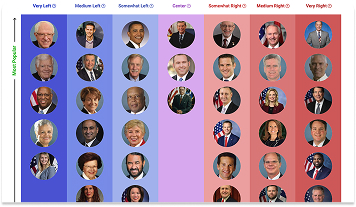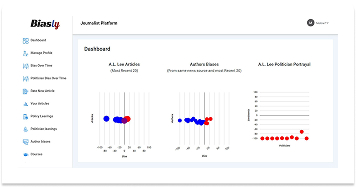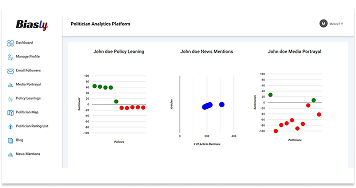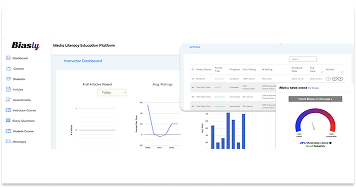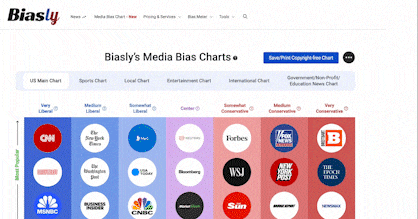Bias Meter
Extremely
Liberal
Very
Liberal
Somewhat Liberal
Center
Somewhat Conservative
Very
Conservative
Extremely
Conservative
-100%
Liberal
100%
Conservative

Biasly determines media bias ratings through a dual-layered approach combining artificial intelligence and analyst review. The platform’s proprietary bias detection engine, Bias Meter, evaluates sentiment, policy position alignment, and language framing across thousands of data points in news articles. Analysts then verify and interpret the AI’s findings, providing additional context where needed. Learn more
- Profile
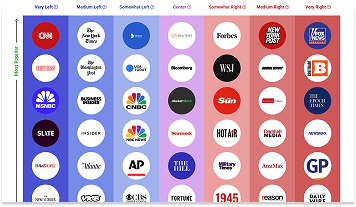
100 Percent Fed Up on the media bias chart
100 Percent Fed Up has a Bias Score of 34% Somewhat Right which is based on a variety of factors including its policy and politician leanings, article ratings, and the use of biased language. Its Reliability is rated as Average, and additional analytical insights are available in the other tabs.
- Bias Rating
34% Somewhat Right
- ReliabilityPolicy Leanings
34% Somewhat Right
Extremely
LiberalVery
LiberalModerately
LiberalSomewhat Liberal
Center
Somewhat Conservative
Moderately
ConservativeVery
ConservativeExtremely
Conservative-100%
Liberal100%
Conservative
Average Reliability
*Our bias meter rating uses data science including sentiment analysis, machine learning and our proprietary algorithm for determining biases in news articles. Bias scores are on a scale of -100% to 100% with higher negative scores being more liberal and higher positive scores being more conservative and 0% being neutral. The rating is an independent analysis and is not affiliated nor sponsored by the news source or any other organization.
Politician Portrayal38% negative
Continue For Free
Create your free account to see the in-depth bias analytics and more.
By creating an account, you agree to our Terms and Privacy Policy, and subscribe to email updates.
Policy Leanings Analysis
Policy | Bias score |
|---|
100 Percent Fed Up Editorial Patterns
100 Percent Fed Up’s coverage of political topics often reflects a Somewhat Right bias, with consistent patterns in phrasing, source selection, and thematic focus that are Lean Right. While many of 100 Percent Fed Up’s articles aim to provide unblemished reports, other articles have a significant amount of opinionated writing and right-leaning issue framing. This article will analyze how 100 Percent Fed Up handles differing viewpoints by studying its coverage and biases.
Coverage of Liberal vs. Conservative Topics
100 Percent Fed Up’s articles frequently discuss societal problems like healthcare, taxes, and gun control. Its articles on these topics align well with conservative viewpoints. They commonly adopt a demeaning attitude toward liberal perspectives while framing these issues to promote conservative ideology.
Conversely, articles that speak to left-wing concepts are typically written in a more negative tone. When reading multiple articles, there is a common theme of articles that poke fun or outright criticize and belittle the liberal mindset. Biasly’s analysis of 100 Percent Fed Up’s writing and authors has come to show a tendency to expand positively upon conservative principles, while simultaneously excluding and possibly besmirching liberal policy.
This media bias can be quite visible within some articles, and less so in others. When it shows, it can be demonstrated within the writer’s tone when regarding each party, or in the number of conservative sources used. When articles are read about conservative politicians/ideology, everything is geared towards praise. Yet when reading articles about liberal politicians, phrases like “sick in the head!” and “disgusting human being” are seen in some writers’ articles.
Policy and Issue Framing
When 100 Percent Fed Up publishes articles about issues like gun laws and taxation policies, they are discussed in a way that favors conservative policies. It aligns with Biasly’s rating of 100 Percent Fed Up as Somewhat Right, as these are common speaking points for right-wing parties and politicians. It also consistently reports positively about issues that concern Donald Trump. The more opinionated articles feature Twitter posts or articles from politicians who agree with their points of view on these controversial issues.
On the other hand, affairs such as climate regulations and healthcare are viewed through a more negative lens. These topics tend to be campaign points for liberals, and conservatives tend to oppose them. Within these issues, most notably with healthcare, which is an especially divisive one, it may back its point with the addition of other topics, such as immigration. That may also involve the public and journalistic perspective on healthcare. These issues are often frowned upon within 100 Percent Fed Up’s articles, and viewed with a Somewhat Right perspective.
Even though some of 100 Percent Fed Up’s articles are more skewed to the right, there are also many articles that approach things from a more neutral point of view. However, even then, there may be instances of bias. In articles that may only seek to report, descriptions such as “appeared to fabricate”, and beginning sentences with “Unsurprisingly,” before being lightly critical of the left, may show up. These can all contribute to bias, even when the writer is doing their best to keep their work objective.
Coverage and Relevance
100 Percent Fed Up’s reporting often addresses issues central to media bias discussions, such as newspaper bias, journalistic bias, and media narratives. As such, it serves as a compelling case study for examining source bias and news media bias in state-focused reporting.
100 Percent Fed Up’s articles frequently touch upon issues of media bias and issues that are widespread in journalism today. 100 Percent Fed Up is an excellent source to analyze when it comes to the study of bias. We analyze things like the political leanings of sources used, bias within journalism as a whole, and the use of framing to better serve their narrative.
Readers who wish to further explore how 100 Percent Fed Up compares with other publications can visit Biasly’s Media Bias Chart to analyze tone and word choice in real time.
100 Percent Fed Up Bias Analysis
100 Percent Fed Up was originally started within a Facebook discussion group by two mothers who wanted to make a difference. In more recent times, it has grown to be a journalistic agency with loyal readers who support their beliefs. 100 Percent Fed Up aims to cover news from both political parties and provide ‘a different take’ on current issues.
According to Biasly’s media bias report, 100 Percent Fed Up has an average of 657,306 monthly visits, which speaks to its reach within its Somewhat Right-leaning audience. When it comes to media bias, both AI and media analysts at Biasly have evaluated its content, sources, and funding to determine its political leaning.
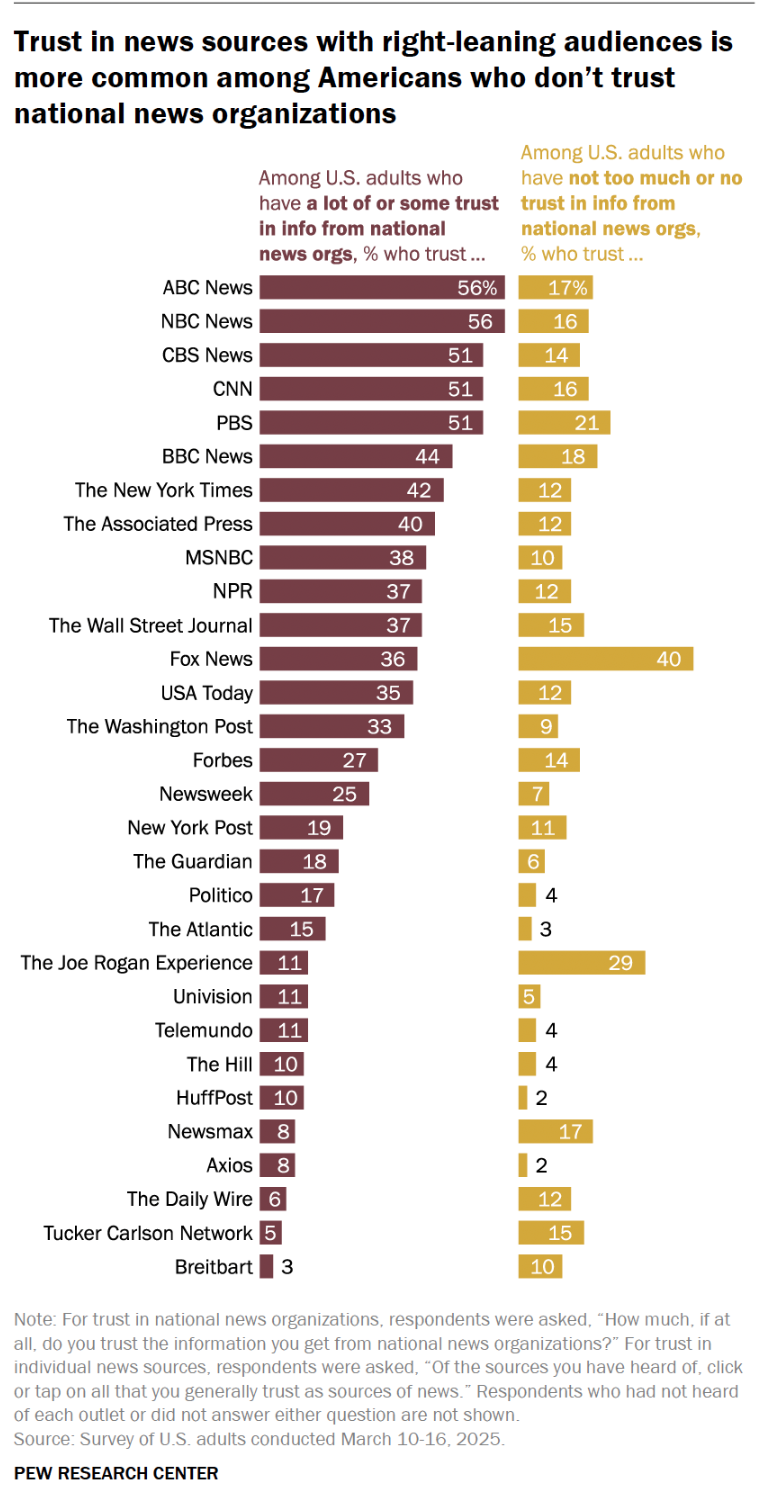
Source: Pew Research
100 Percent Fed Up’s audience aligns well with what its writers have a tendency to express. As the chart above shows, most right-leaning audiences distrust the national media news sources. Smaller news outlets, like 100 Percent Fed Up, garner more traffic from viewers such as these because they create more trust. This article digs into 100 Percent Fed Up to see if there is heavy media bias present, and how heavily it is, if so.
Is 100 Percent Fed Up Biased?
Based on Biasly’s evaluations, 100 Percent Fed Up is rated as Somewhat Right.
By examining content patterns and the broader context of media influence, we aim to offer a balanced perspective on 100 Percent Fed Up’s political bias, and contribute to the ongoing discussion about bias in the news.
How Does Biasly Rate News Sources?
Biasly uses proprietary algorithms and a team of analysts to provide comprehensive bias evaluations across thousands of news outlets. Over 200,000 articles from more than 3,200 sources have been analyzed to identify the most accurate and unbiased stories.
Biasly assigns each outlet three key scores:
- Reliability Score – Reflects factual accuracy
- AI Bias Score – Generated via natural language processing
- Analyst Bias Score – Assessed by human political analysts
These scores are based on seven core metrics: Tone, Tendency, Diction, Author Check, Selection/Omission, Expediency Bias, and Accuracy. These elements help analysts and algorithms evaluate the political attitude conveyed by each article.
Biasly’s Bias Meter ranges from -100% (most left) to +100% (most right), with 0% indicating neutrality. The system evaluates individual articles based on political terms, policies, figures, and sentiment to calculate precise bias ratings.
Is 100 Percent Fed Up Politically Biased?
100 Percent Fed Up earns a Somewhat Right rating for its AI Bias Score and a Somewhat Right rating for its Analyst Bias Score. The Analyst Bias Score is generated by reviewers from liberal, moderate, and conservative backgrounds. 100 Percent Fed Up articles were reviewed, and a consistent inclination toward the right in areas like healthcare and gun laws was shown.
To align with their Somewhat Right score, most articles tend to touch on topics important to the conservative party. There are, however, multiple articles that maintain a more objective point of view and report facts only.
A 100 Percent Fed Up writer noted in an article:
“And yet, the Democrat leaders in D.C. have unconstitutionally employed some of the strictest gun control laws in the entire nation in our capital city — which President Trump’s task force is now combating.”
100 Percent Fed Up’s readers span across all of the United States. Referring back to Pew’s article about right-leaning audience trust in national news sources, it is these viewers who turn to sources like 100 Percent Fed Up for their consistent news coverage.
100 Percent Fed Up’s bias score is determined through natural language processing that evaluates the voice, the language used, and the sway within the reporting. Recent AI evaluations highlight conservative narratives in articles discussing the Democratic Party and socialized healthcare.
Analysis of Bias in 100 Percent Fed Up Online Articles
100 Percent Fed Up has found that in-depth coverage and opinionated writing on perceived failures of the Democratic Party are the best way to appeal to readers. Given that much of its readership is right-wing, it’s essential to ask: is 100 Percent Fed Up truly biased?
100 Percent Fed Up has its niche in appealing to and agreeing with conservative readers. This has grown their platform exponentially from their foundation in 2011. Since most of their readers fall into one camp of the political spectrum, the question of 100 Percent Fed Up’s bias – if any – is an important one to consider.
To evaluate this, we can analyze select 100 Percent Fed Up articles through several of Biasly’s bias rating criteria: Tone, Tendency, Author, Diction, and Expediency Bias.
- Tone: The overall attitude conveyed by the article
- Diction: Specific word choices made by the writer
- Author: The background and social presence of the journalist
- Tendency: Patterns of bias in the writer’s broader body of work
- Expediency Bias: Quick visual or textual indicators like headlines and photos that imply bias

Source: Somewhat Right
An example article for the above rating criteria is the following article’s headline. This headline does a good job of appealing to the audience, as it includes a picture of Donald Trump frowning toward the headline. This perceived disappointment and the capslock “HILARIOUS” resonate well with 100 Percent Fed Up’s readers, who will likely agree with the sentiment expressed in the photo and the headline.
Reporter Anthony opines briefly on how he finds the situation “hilarious”. Further within the article, he adds Tweets and remarks that provide an overview of the situation and the issue itself. The objectivity of the article is thrown into question with phrases that do not maintain a neutral standpoint. Two examples are:
“Okay, this was hilarious.”
“My wonder President Trump calls mainstream media fake news!”
The article slants to the more conservative side when relying on the author’s opinion rather than neutral news sources summarizing events. With portions of the headline in all caps and dead between quotation marks, it links the audience with the article. The article’s conservative bias can be seen in the phrases above, alongside the way that the sources are presented. This all culminates in further cementing the belief that 100 Percent Fed Up has a right-wing bias.
Conversely, another article, by the name of “Kamala Harris To Receive Protection From New Source Following Secret Service Detail Removal”, offers a more unbiased point of view. There are still some instances of occasional swinging toward the conservative side, such as the lack of positive opinion. This article is more balanced and report-centric. It lays out the facts without using any belligerent wording, and explains it all with an even tone. An example of this can be found in this quote:
“The development follows President Trump’s revocation of her Secret Service detail.
The outlet explained that Los Angeles Mayor Karen Bass and Gov. Gavin Newsom’s office coordinated the arrangement after the removal of Harris’ Secret Service protection.”
This specific article uses language with the purpose of providing information without opinionating upon it. The article shows people’s thoughts near the end. Examples are from X users, also in accordance with what the New York Post has said about Kamala Harris’ book tour. The author uses words such as “development” and “about to begin”, which help her maintain an even tone and express further interest to stay abreast of the topic. These words do not express the author’s opinion, and serve only to give the public the information that was accessible at the time.
To conclude this section, 100 Percent Fed Up shows a relative right-leaning bias throughout its reporting. While Danielle’s writing maintains a reasonably middle-ground perspective, Anthony’s article about Donald Trump’s perceived death contrasts it with a notably more opinionated ideology. The author’s addition of personal opinion makes it difficult to consider the overall bias of the reporting agency. Despite attempts at balance in some reporting, 100 Percent Fed Up’s tendency to highlight conservative initiatives can be clearly seen. This is true in articles that mock the liberals, and also within those having to do with hot-seat topics such as gun laws or climate change.
Analysis of 100 Percent Fed Up Opinion Articles
To fully understand political bias in the media, it’s important to distinguish between factual reporting and opinion pieces. While reporting aims to present facts and let readers form their own conclusions, opinion articles express personal viewpoints on current issues. Although the previous section examined some factual reporting, this section will fully explore how bias surfaces through 100 Percent Fed Up’s selection and tone of opinion content.
An excellent example of this is the following article, “INFURIATING: California Spending $9.5 BILLION On Free Healthcare For Illegal Aliens”. The title clearly indicates that this is an opinionated article. The Caps Lock for the words “INFURIATING” and “BILLION” signal anger at the amount of money used by the Californian government for this purpose. The article itself contains many quotes in which the author expresses her dissatisfaction with the whole concept. Irritation with the amount of money, and that it is being spent on people who are currently illegal in the United States.
On the other hand, a second opinion piece – “Here’s How Much You’ll SAVE In Taxes Under Trump’s Big Beautiful Bill” – offers a lighter opinion and generally unbiased information. This article stays central more than it skews to the right. It is not entirely neutral, as can be seen with the caps lock “SAVE”, but that is in accordance with the way that 100 Percent Fed Up has been rated by Biasly. The article itself contains little opinionated language, mainly quotes from other sources, or an explanation of what the Big Beautiful Bill is.
The opinionated articles provided as examples make it clearer still that 100 Percent Fed Up’s bias toward being “Somewhat Right” is true. The platform often provides content that leans toward the conservative. This consistency can contribute to a higher bias level and a downfall of objectivity.
This tendency underscores the importance of distinguishing subjective viewpoints from straight reporting, especially when interpreting the political leanings of any news organization.
Who Owns 100 Percent Fed Up?
100 Percent Fed Up was co-founded by Patty McMurray and Leisa Audette. They both founded it in 2011, after many discussions about being unsatisfied with the political climate of America at that time. It started out as a Facebook page and has grown to up to 657,306 monthly visits. In 2023, Patty McMurray left the source, but Leisa remains.
100 Percent Fed Up works off of donations received from the readers, or affiliate links from products they may recommend. A store can also be found on their website, where various clothing items can be bought. Posts about donation and/or support can be seen.
This business model also contributes to their rating of “Somewhat Right”. While donations may only be a way to stay afloat, the affiliated links and store can provide extra information about 100 Percent Fed Up’s tendencies. By garnering support from like-minded right-wing readers, it is easier for 100 Percent Fed Up to uphold their ratings.
How to Evaluate Bias
Although Biasly rates 100 Percent Fed Up as Somewhat Right, it’s important to remember that bias can vary from article to article. 100 Percent Fed Up also covers numerous centrist topics with a fair degree of objectivity. It not only remains rooted in its right-wing ideology. This complexity underscores the importance of examining each article individually. So, let’s learn how to evaluate media bias.
Recognizing media bias requires awareness and critical thinking. Often, readers trust news sources that affirm their existing beliefs—a psychological tendency known as confirmation bias. This makes it harder to identify slanted narratives or one-sided reporting.
To combat this, it’s essential to challenge your assumptions by consulting multiple viewpoints and verifying news through third-party analysis. Tools like Biasly’s media bias ratings allow readers to compare the same news story across the political spectrum.
Ultimately, bias isn’t always a matter of what is said—it’s also about what is left out, how topics are framed, and which stories are chosen for coverage. Learning to recognize these patterns can help readers make more informed decisions and develop greater media literacy.
To start comparing news outlets and gain a better understanding of bias, sign up for Biasly’s Media Bias & News Analytics Platform to see how stories vary between sources.
100 Percent Fed Up Reliability Analysis
Is 100 Percent Fed Up Reliable?
100 Percent Fed Up finds itself toward the middle of the spectrum, with neither high nor low accuracy. Its status as a local news outlet contributes to its moderate reputation for reliability. According to Pew Research, Americans generally hold less politically polarized views toward local news compared to national media. In fact, 85% of adults regard local journalism as at least somewhat important to their community. This is in accordance with 100 Percent Fed Up. It is a relatively small source run by ordinary people.
This suggests that 100 Percent Fed Up’s popularity is not fabricated, as there are many readers who support what is being said and agree. Further investigation is needed to determine whether bias or other factors are affecting its accuracy. At Biasly, we specialize in evaluating not just bias but also the reliability of media outlets. Let’s explore the accuracy and trustworthiness of 100 Percent Fed Up.
How to Evaluate Reliability?
Reliability refers to how trustworthy or accurate a news source is. If we can’t trust what we read, then continuing to consume content from that outlet serves little purpose. So how do we evaluate a news outlet’s reliability?
There are several potential measures of reliability to look out for when trying to determine whether a media source is reliable or not. Red flags for an unreliable article can include the presence of wild, unsubstantiated claims, facts dependent on other unreliable sources, heavy use of opinionated language, and more. In contrast, hallmarks of a reliable source include:
- Absence of subjective language
- Citing credible sources (e.g., .gov, .edu, academic references)
- Verifiable facts and statistics from multiple outlets
- Use of primary sources, like interviews or transcripts
- Consistency with coverage across other platforms
Biasly’s reliability scores incorporate these elements in evaluating media outlets.
So How Does 100 Percent Fed Up Fare in Its Reliability?
The political reliability index developed by Biasly assesses both accuracy and trustworthiness. 100 Percent Fed Up currently holds Average Reliability Score, which is calculated as a weighted average of:
- Fact Analysis Score – Evaluates the accuracy of claims, facts, and evidence.
- Source Analysis Score – Assesses the number, diversity, and credibility of sources and quotes used.
100 Percent Fed Up’s Source Analysis Score is rated Average at 45% Reliable. This suggests moderate trustworthiness in its sourcing practices. The score is AI-generated and considers quote length, frequency, diversity, and quality.
The Fact Analysis Score has yet to be finalized. This score will further determine how well 100 Percent Fed Up supports its claims, addresses selection and omission bias, and presents verifiable evidence. Until this is available, readers are encouraged to perform their own evaluations using Biasly’s media bias tools.
100 Percent Fed Up falls in the middle of the spectrum, neither overly reliable but also not entirely falsified. Occasional lapses—such as unbalanced viewpoints or incomplete data—can affect its reliability rating. These nuances emphasize the importance of analyzing individual articles.
100 Percent Fed Up’s Accuracy and Reliability
According to Biasly’s analysis, 100 Percent Fed Up maintains Average Reliability Score, but individual articles may vary significantly. Let’s dive into the details.
Political orientation plays a crucial role in how audiences perceive reliability. 100 Percent Fed Up has been known for writing to support a conservative narrative, potentially at the expense of factual reporting. To validate such claims, it’s essential to analyze whether the publication backs its assertions with sufficient evidence and diverse viewpoints.
Two common types of bias that affect factuality include:
- Selection Bias – Highlighting or omitting stories to fit a particular narrative.
- Omission Bias – Leaving out differing perspectives or relevant details to skew perception.
Biasly’s accuracy ratings use a scale from 1% (least accurate) to 100% (most accurate). Factors include the presence of supporting evidence, internal and external reliable sources, and balanced viewpoints.
As an example, Biasly gave the source Foreign Affairs a central point of view and a Limited Reliability Score. One Foreign Affairs article, titled “Can Iran Save Itself?”, showed a limited reliability rating. This was for failing to include diverse viewpoints and for a low total number of sources. There is a lightly critical language toward the Iranian regime throughout the text, and several quotes from Donald Trump underlining what he wants to do regarding Iran. These quotations shift the ideology of the article to a more conservative one, as the usage of words verbatim from Donald Trump highlights. An example quote from author Mohammad Ayatollahi Tabaar’s article:
“Trump has also said his administration is down to the final moments with Iran.”
This quotation further cements the belief that this article was skewed to the right. The quotation paints Iran in a more negative light and emboldens the conservative perspective. By using a quote that implies that Donald Trump’s administration is “down to the final moments”, it creates a sense of urgency and of support for Donald Trump’s administration.
We will take a closer look at more examples like this below to provide a further investigation into the reliability of 100 Percent Fed Up’s articles. This will include its use of selection bias, omission bias, and the quality of its sources and the facts it uses.
Analysis of Reliability in 100 Percent Fed Up’s Online News Articles
100 Percent Fed Up’s goal is to comment on political situations in a way that may differ from mainstream media. Its staff includes writers from what is typically a right-wing background, although many of 100 Percent Fed Up’s articles present their findings in an objective manner. However, readers should distinguish between news reporting and opinion pieces to evaluate credibility effectively.
One notable example is the article titled “Our Mission Is Not Complete: National Guard Deployment in D.C. EXTENDED to December”. The article has fragments of opinionated writing at the start. Quotes like “restore our nation’s capital to its former glory” and “already been reduced to nearly zero” can be seen. However, the article itself is informative and sticks to fact-based language. Despite 100 Percent Fed Up’s Somewhat Right rating, this piece illustrates factual neutrality.
Quality of Sources and Facts Used
100 Percent Fed Up often uses credible X posts or videos from conservative politicians and/or speakers to bolster their articles. Some of these articles skew in how they present opposing viewpoints, as there is often a distinct lack of content favoring liberal policies.
One such case can be explored with an article titled “UN BULLDOZES Amazon Rainforest For Climate Summit, Irony Much?”. Even though it contains multiple sources and does a solid job at explaining what had happened, the overall tone of the sources and facts contains bias. An example can be found in the following quote used in the article, from the New York Post, “Somebody get Greta on the horn!”. This quotation and the overall tendency of agreeing that destroying a portion of the Amazon to host a convention on climate there sounds ludicrous.
Within this article, there are no instances of differing perspectives found. Much of the article speaks badly about the liberal perspective and highlights the apparent irony of the situation. There are no circumstances in which the situation is spun into a positive light, even though there may have been other sources that agreed with it.
An example of an article that stays more objective is this article by Danielle. Here, she pulls from sources like Fox News, NBC News, and RedWave Press to provide information on Joe Biden’s cancer surgery and diagnosis. It features multiple sources from all across the political spectrum. They are presented from a neutral position, allowing the reader to make their own conclusions. There is no opinionated writing within it, and the quotes are shown without any bias.
The article is bolstered by 4 proper quotes and 5 posts, each from various news sources. Within these quotations and/or posts, there is a lot of variety in their sources and in their general inclinations. As shown through Biasly’s media bias chart, Fox News falls in “Very Right”, and NBC News falls “Somewhat Left”. They are also primary sources, and quotes from recognizable news outlets help build trust between the article’s concept and the audience.
All of the sources used and their biases are the following:
- NBC News, “Somewhat Left”
- Mayo Clinic, there is no bias available, as Mayo Clinic is a health institution, used to speak about the kind of cancer Joe Biden has
- Fox News, “Very Right”
- RedWave Press, does not have an official Biasly rating yet, but its X bio presents it as a “conservative news source”
- CNN, “Very Left”
Again, shown by the sources above, this article includes a great diversity of sources used. There are three conservative ones and two liberal ones, with the exclusion of Mayo Clinic, as it is a health institution. The information presented is objective and stays balanced. The sources allow the reader to think what they want, and that maintains the article and the information impartially.
The article often relies on large news outlets, which may improve viewer trust in 100 Percent Fed Up’s article. As it usually only includes right-wing posts/information, the information from news sources that are more left-leaning is helpful. Even though none of the information expresses any opinion, the inclusion of varied sources lends this article a high level of fairness.
Selection and Omission Bias
100 Percent Fed Up aims to provide information and analysis of the political climate within the United States. Even with that, though, bias may still be found through their usage of language and their decisions to omit or select stories.
In “WATCH: Deranged Leftists PROTEST President Trump Ridding D.C. Of Crime”, selection bias and omission bias are both present. They bleed through in the article’s negative portrayal of the protesters. The article does not touch upon positive points of view of the protests, which plays into omission bias by omitting beliefs from the opposite side.
This article includes very little positive information. What it includes is at the end of the article and sourced from Reuters. It is presented and then opined on with a negative slant. After analyzing this article, it is clear that this article leans rather heavily to the right. The author bashes the protesters and the left wing with comments that could be interpreted as snide. They also suggest, without clear evidence, that protesters may have been paid by an unknown organization. That said, sources that the author got these posts and/or articles from; Leading Report, Reuters, and Fox, are reputable sources. These offer clear information aside from the author’s own opinions.
By comparison, the article “President Trump Considering Striking Drug Cartel Targets Inside Venezuela, Report Claims” shows a more strongly objective stance. Author Danielle provides evidence and articles from various reputable sources.
These sources are presented with no author opinion. They are all only informing about Donald Trump’s thoughts on Venezuela’s drug cartels. These sources are also consistently linked, making it easy for 100 Percent Fed Up’s audience to self-check them. None opine on the subject matter at hand, which bolsters author Danielle’s article’s unbiased fact reporting. There is no discernible selection or omission bias within this article.
In opinion pieces, issues with factuality, sources, selection, and omission are frequently present. The articles we’ve covered so far reflect 100 Percent Fed Up’s Somewhat Right views, and understanding these can assist in better grasping its rating. Its story selection favors issues that concern conservatives, and it is easy to assume that liberal topics are then looked at negatively. Yet, the contents of 100 Percent Fed Up’s article often maintain accuracy, and are seen citing from varied news sources.
So, Is 100 Percent Fed Up Reliable?
Overall, 100 Percent Fed Up can be considered an outlet that is moderately reliable. Its articles often include opinion-driven writing, inconsistent sourcing, and occasional editorial framing on sensitive topics. While some claims are well-supported, greater consistency in sourcing and balance would improve its journalistic standards.
As media literacy improves, readers can more easily detect issues with selection bias, omission bias, and factuality. To strengthen your ability to assess reliability across the political spectrum, use the News Bias Checker to compare how multiple outlets report the same story.
This empowers you to consume more accurate, balanced, and dependable news.
Additional Insights
News Source Comparison
When it comes to news source comparison, 100 Percent Fed Up is often evaluated alongside other regional and national outlets that lean right or somewhat right. Sources like Forbes, New York Post, and The Sun often present similar tones and editorial philosophies. While 100 Percent Fed Up maintains a Somewhat Right media bias, it may differ from others with similar ratings in the frequency of author bias and the amount of diversity within sources used.
This puts it in contrast with media outlets that have been analyzed to fall more toward the center. Readers seeking balanced political coverage may compare 100 Percent Fed Up’s framing of issues with outlets rated as Center or Lean Right on our Media Bias Chart, or explore other regional papers on our Similar Sources page.
Notable Contributors and Authors
100 Percent Fed Up features several reporters, many of whom share 100 Percent Fed Up’s right-wing views. Reporters like Danielle, who often report on US political happenings and global news. She shows 100 Percent Fed Up’s commitment to providing their readers with clear information and a different way of viewing politics.
Other contributors focus on immigration, gun laws, and healthcare, topics that are central to the conservative party. While some contributors may be seen as leaning right in tone, their work is generally grounded in factual reporting. The presence of recurring bylines helps readers evaluate individual journalists’ bias over time.
Related Tools and Resource Pages
To better understand how 100 Percent Fed Up fits into the broader media landscape, we recommend exploring these helpful resources:
- Media Bias Chart: See what the most common news sources across the political spectrum are.
- Political Bias Chart: Observe the political leanings of popular politicians/commentators across the political spectrum.
- Journalist Bias Analytics Platform: Explore how individual journalists contribute to bias within their publications.
- Politician Bias Analytics Platform: Compare how politicians are framed differently by 100 Percent Fed Up and other outlets.
- Media Literacy Education Platform: Valuable information on how to assess media sources and determine what is true and what is not.
Frequently Asked Questions
100 Percent Fed Up is rated as moderately reliable. based on Biasly’s media bias algorithm, which assesses sentiment, article framing, and policy favorability.
Yes, but with caution. 100 Percent Fed Up’s articles may often slant to the right, including things such as the author’s opinion or issue framing to better suit their narrative. These things may impact their news reliability.
Biasly uses a combination of AI sentiment analysis and human analyst review to assess tone, fact accuracy, source quality, and media bias indicators. Learn more on our Bias Meter page.
Ratings are based on recent news using data science and A.I. technology.
Military Spending
| Date | Sentiment | Associated Article | Snippet |
|---|---|---|---|
| 08/25/2019 | 75% For | Trump Family Detentions Flores Agreement (link) | So, of course, the Trump administration is doing the opposite in a baldfaced |






















